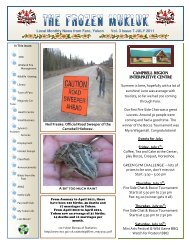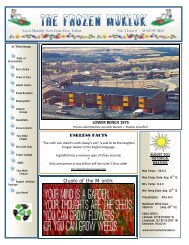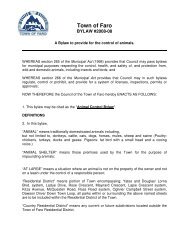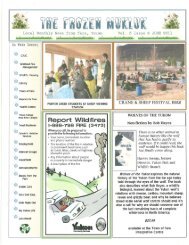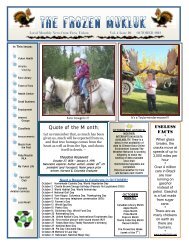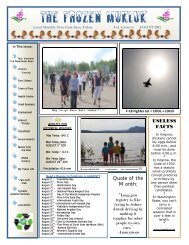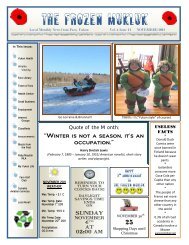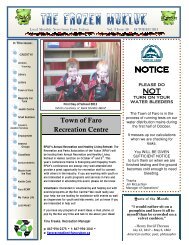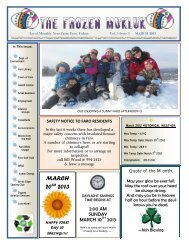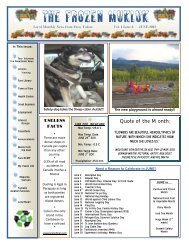The Frozen Mukluk
The Frozen Mukluk Vol. 5 Issue 05 May 2013 - Town of Faro
The Frozen Mukluk Vol. 5 Issue 05 May 2013 - Town of Faro
- No tags were found...
You also want an ePaper? Increase the reach of your titles
YUMPU automatically turns print PDFs into web optimized ePapers that Google loves.
miscellaneousHOMEMADE MOSQUITOTRAP:Items needed:200 ml water50 grams of brown sugar1 gram of yeast2-liter plastic bottleOr US conversion:1 cup of water1/4 cup of brown sugarHOW:1. Cut the plastic bottle inhalf.2. Mix brown sugar with hotwater. Let cool. When cold,pour in the bottom half ofthe bottle.3. Add the yeast. No needto mix. It creates carbondioxide, which attractsmosquitoes.4. Place the funnel part,upside down, into the otherhalf of the bottle, tapingthem together if desired.5. Wrap the bottle withsomething black, leaving thetop uncovered, and place itoutside in an area awayfrom your normal gatheringarea. (Mosquitoes are alsodrawn to the color black.)Change the solution every 2weeks for continuouscontrol.Natural Homemade SunscreenINGREDIENTS:1/2 cup almond or olive oil (can infuse withherbs first if desired)1/4 cup coconut oil (natural SPF 4)1/4 cup beeswax2 Tablespoons Zinc Oxide (This is a nonnanoversion that won’t be absorbed intothe skin. Be careful not to inhale thepowder). This makes a natural SPF of 20+ ormore can be added.)Optional: 1 teaspoon Vitamin E oilOptional: 2 tablespoons Shea Butter (naturalSPF 4-5)Optional: Essential Oils, Vanilla Extract orother natural extracts to suit yourpreferenceDIRECTIONS:-Combine ingredients except zinc oxide in apint sized or larger glass jar. I have a masonjar that I keep just for making lotions andlotion bars, or you can even reuse a glass jarfrom pickles, olives or other foods.-Fill a medium saucepan with a coupleinches of water and place over mediumheat.-Put a lid on the jar loosely and place in thepan with the water.-As the water heats, the ingredients in thejar will start to melt. Shake or stiroccasionally to incorporate.-When all ingredients are completelymelted, add the zinc oxide, stir in well andpour into whatever jar or tin you will use forstorage. Small mason jars (pint size) aregreat for this. It will not pump well in alotion pump!-Stir a few times as it cools to make surezinc oxide is incorporated.-Use as you would regular sunscreen. Best ifused within six months.www.wellnessmama.comOVEN BAKED SHRIMPMelt a stick of butter in the pan.Slice one lemon and layer it on topof the butter. Put down fresh shrimp,then sprinkle one pack of driedItalian seasoning. Put in the ovenand bake at 350 for 15 min. BestShrimp you will EVER taste:)Look up!May 4, 5 - Eta Aquarids Meteor Shower.<strong>The</strong> Eta Aquarids is an above average shower,capable of producing up to 60 meteors per hour atits peak. Most of the activity is seen in theSouthern Hemisphere. In the Northern Hemisphere,the rate can reach about 30 meteors per hour. It isproduced by dust particles left behind by cometHalley, which has known and observed sinceancient times. <strong>The</strong> shower runs annually from April19 to May 28. It peaks this year on the night of May4 and the morning of the May 5. <strong>The</strong> secondquarter moon will block out some of the lessbright meteors this year but you should still beable to see quite a few good ones if you arepatient. Best viewing will be from a dark locationafter midnight. Meteors will radiate from theconstellation Aquarius, but can appear anywhere inthe sky.May 10 - New Moon. <strong>The</strong> Moon will bedirectly between the Earth and the Sun and willnot be visible from Earth. This phase occurs at00:28 UTC. This is the best time of the month toobserve faint objects such as galaxies and starclusters because there is no moonlight to interfere.May 10 - Annular Solar Eclipse. An annularsolar eclipse occurs when the Moon is too faraway from the Earth to completely cover the Sun.This results in a ring of light around the darkenedMoon. <strong>The</strong> Sun's corona is not visible during anannular eclipse. <strong>The</strong> path of the eclipse will beginin western Australia and move east across thecentral Pacific Ocean.May 25 - Full Moon. <strong>The</strong> Moon will bedirectly opposite the Earth from the Sun and willbe fully illuminated as seen from Earth. This phaseoccurs at 04:25 UTC. This phase occurs at 11:09UTC. This full moon was known by early NativeAmerican tribes as the Full Flower Moon becausethis was the time of year when spring flowersappeared in abundance. This moon has also beenknown as the Full Corn Planting Moon and the MilkMoon.May 28 - Conjunction of Venus andJupiter. Conjunctions are rare events where two ormore objects will appear extremely close togetherin the night sky. <strong>The</strong> two bright planets will bewithin 1 degree of each other in the evening sky.<strong>The</strong> planet Mercury will also will also be visiblenearby. Look to the west near sunset. May 25 - Penumbral Lunar Eclipse. Apenumbral lunar eclipse occurs when the Moonpasses through the Earth's partial shadow, orpenumbra. During this type of eclipse the Moonwill darken slightly but not completely. <strong>The</strong> eclipsewill be visible throughout most of North America,South America, western Europe, and westernAfrica.



